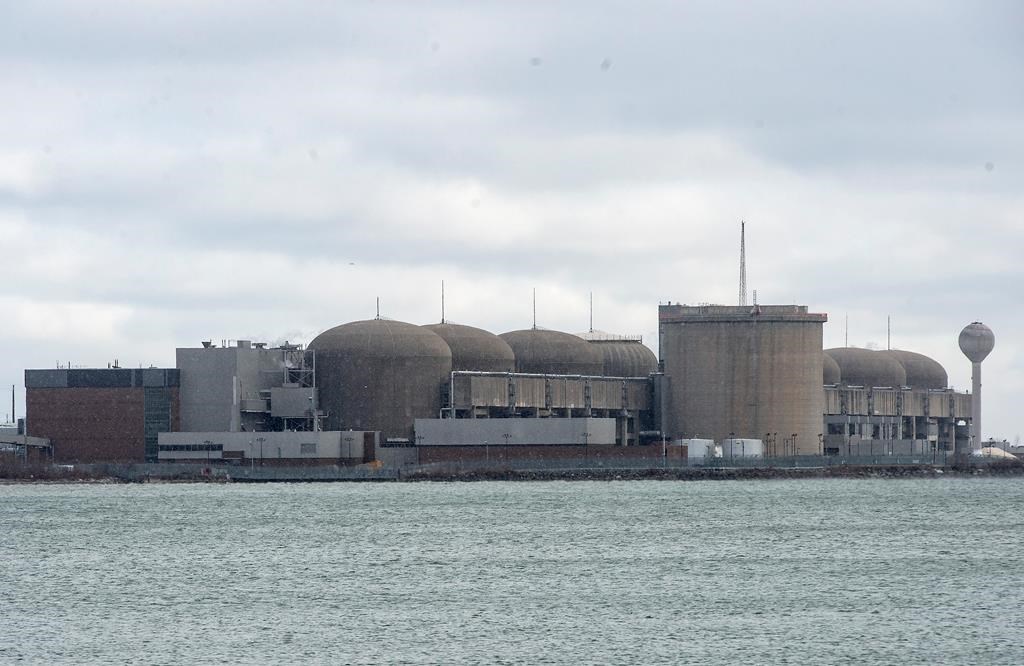PICKERING, Ont. — Ontario is considering refurbishing a key nuclear plant, which could keep it in service for an extra 30 years, to keep pace with electricity demands that are rising so quickly they have “surprised” the government, the energy minister said Thursday.
Pickering Nuclear Generating Station — which accounted for 14 per cent of electricity generation last year — had been set to shut down in 2025, but the province is now seeking approval from the Canadian Nuclear Safety Commission to extend that to September 2026, Energy Minister Todd Smith announced.
Beyond that, the plant may still have the potential to power a portion of the province for decades to come, Smith said, and the province has asked Ontario Power Generation to do a refurbishment feasibility assessment.
The Independent Electricity System Operator recently said that it was confident it could fill the electricity supply gap created by Pickering coming off-line — and other units undergoing refurbishment — through new procurements that will heavily rely on natural gas, at least in the short term.
But Smith suggested that “unprecedented growth” in Ontario means the province may need to harness the large-scale capacity of Pickering for a while longer.
“I think that growth has surprised even Premier (Doug) Ford and our team,” he said at a news conference Thursday.
Smith pointed to new electric vehicle and EV battery manufacturing coming to the province, as well as steelmakers using electric arc furnaces.
“One of the things as we were exploring opportunities on how we fill that (supply) gap is we’ve got an existing asset here that has a proven track record of providing safe and reliable electricity and affordable electricity every day … We have to be able to ensure that as we continue to see investment in our province, that the power is going to be there.”
Extending Pickering for a year gives more of a cushion for the generation from the new procurements to come online, Smith said.
Interim NDP Leader Peter Tabuns suggested the government should have started anticipating and planning for the supply gap much sooner.
“Premier Doug Ford failed to plan for Ontario’s energy needs and that’s put the province in a bind,” he said in a statement.
“The Conservatives cancelled and dismantled low-price renewable energy generation, then had to sign contracts last month to ratchet up very expensive gas-fired power.”
The Progressive Conservatives removed a requirement put in place by the former Liberal government to update the province’s long-term energy plan by February 2021. The last plan was published in 2017.
Rupp Carriveau, director of the Environmental Energy Institute at the University of Windsor, said Thursday’s announcement was a bit surprising given that the government had recently signalled it was not, in fact, considering an extension at Pickering.
But, he said, as much as he would rather not see a long-term reliance on Pickering — because of concerns around nuclear waste management — the “realist” in him thinks it’s probably needed.
“This push towards electrification, it seems nice when you see the electric car commercials, but it’s going to be very difficult,” Carriveau said in an interview.
“I’m pro-electrification, I’m pro-clean solutions, but the truth is, it is very difficult to do in a clean way, in the short term. I think we’re going to have a challenge meeting (emission reductions) targets.”
IESO projections show a growing supply gap of electricity, as broader electrification takes off, particularly in the transportation sector.
Demand from growth in electric vehicles and electrifying public transportation is expected to rise much more quickly starting in about 2035. Around then, the projected gap between needed and available electricity is expected to hit 5,000 megawatts — enough to power five million homes — during the summer, even if all current power producers renew their contracts.
The longer-term procurement is looking to include more non-emitting resources to the generation portfolio, including small modular nuclear reactors.
Smith has also asked the IESO to report back on the potential for a moratorium on new natural gas generation, as well as a plan to get to zero emissions in the electricity sector. The current reliance on natural gas means greenhouse gas emissions from the electricity sector are set to increase.
At the Thursday announcement, Smith stressed the emissions-free nature of nuclear power. Keeping Pickering operational to 2026 will reduce emissions by 2.1 million tonnes that year, akin to taking 640,000 cars off the road, Smith said.
The Ontario Clean Air Alliance, which advocates for a completely renewable energy system, criticized the plan to extend the life of the nuclear plant that it said “has long exceeded its engineering life span.”
“This terrible idea is where you end up if you ignore better alternatives, like rapidly expanding use of much lower cost solar and wind, getting back to promoting ultra low-cost energy efficiency to lower bills while saving power, and co-operating with your energy rich neighbours in Quebec,” the group said in a statement.
Two older units known as Pickering A, which came online in the 1970s and were refurbished in the early 2000s, are still set to shut down in 2024. Four Pickering B units, which came online in the 1980s, are the ones that the government is eyeing for extension and refurbishment.
Ken Hartwick, OPG’s president and CEO, said Pickering will be able to run safely until 2026. He answered questions about the costs of extending its life by a year by saying it will be a “net ratepayer benefit.”
The Canadian Manufacturers and Exporters welcomed the refurbishment potential, saying it would ensure reliable power for producers of electric vehicles, green steel and critical minerals, as well as creating more than 1,000 manufacturing jobs during the construction phase of refurbishment.
This report by The Canadian Press was first published Sept. 29, 2022.



